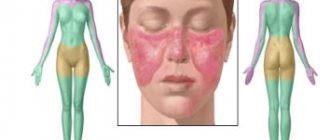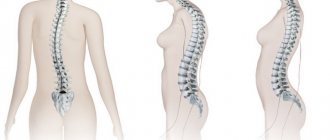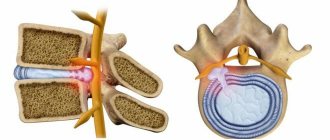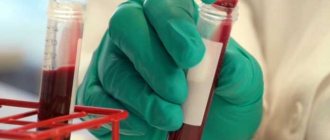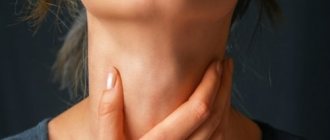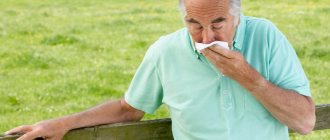Spinal pathologies are very common today among people of different ages and genders. One of them is juvenile kyphosis or Scheuermann-Mau disease, which manifests itself in a backward curvature of the spine, with an angle of inclination greater than forty-five degrees. This contributes to the development of a large number of complications from the respiratory, nervous and cardiovascular systems.
This disease is popularly called stoop (hunchback). In most cases, the disease develops due to injury or a disorder of the development of the muscle tissue of the back, often combined with scoliosis. The pathology occurs in adolescence, when intensive bone growth occurs, to the same extent in boys and girls.
Description of the problem
Juvenile kyphosis
Scheuermann-Mau syndrome is a pathology of the spine in which its curvature occurs more than forty-five degrees backward. In advanced cases, the disease leads to neurological disorders.
A healthy human spine has four curves, two of which are inclined forward and two backward. These bends make it possible to withstand dynamic and statistical loads, maintain balance, and soften shocks when a person moves. Their angles range from twenty to forty degrees.
With this pathology, some vertebrae, usually the seventh, eighth and ninth thoracic vertebrae, take the shape of a wedge, the angle of curvature can increase to seventy-five degrees, so the back becomes round, a hump is formed, Schmorl's hernias appear, the structure of the chest changes, causing tightness of the internal organs.
Scheuermann-Mau disease
A healthy spine always has natural curves. They help a person move smoothly, maintain an upright body position and resist external influences. If a disorder develops, it affects only the vertebrae involved in the formation of thoracic kyphosis. Thus, the deformation angle, instead of the physiological 20 - 40 degrees, increases to 45 - 75 degrees. For this reason, the load on the spine is redistributed. The affected part experiences increased influence, gradually leading to an increase in the angle of deformation.
The stronger the curvature of the thoracic part, the more pronounced the disturbance in the shape of the vertebrae themselves. They become wedge-shaped, with some of the wedges directed forward. The cartilaginous intervertebral discs also become thinner in places where the vertebrae begin to touch more closely. A characteristic manifestation of the disease as it progresses is the collapse of part of the intervertebral disc into the vertebral body.
In addition, the pathology also negatively affects the ligaments that should normally secure the spine. But under the influence of uneven load they become thicker, which means that the spine stops doing its job properly, and the further growth of the vertebrae in adolescence changes.
Disease code according to ICD-10: M42 – Juvenile osteochondrosis of the spine.
Reasons for the development of the syndrome
Reasons for the development of the syndrome
In medicine, the exact causes of the formation of the disease are not known. Presumably, juvenile kyphosis develops as a result of hereditary and genetic predisposition. Provoking factors are injuries during the period of bone tissue growth, the presence of osteoporosis, a disorder in the development of muscle tissue, necrosis of the vertebral plates, disruption of the hormonal system, metabolic processes in the body, and blood circulation. Also, disturbances can occur due to accelerated bone growth in one area of the spine and slower growth in another area, low weight of the child, and endocrine system disorders. In some cases, the disease begins to develop due to psychological discomfort. Being tall, some teenagers experience psychological stress. They cannot accept their height, so they begin to slouch and hunch over.
Note! This disease is named after the radiologist Scheuermann, who considered the cause of the development of the disease in the necrosis of hyaline cartilage that separates the intervertebral discs.
In older people, the disease can develop due to advanced pathology in adolescence, poor physical fitness, and the presence of concomitant diseases, for example, tuberculosis, arthritis or cancer. In modern times, the most common cause of the syndrome is an unhealthy lifestyle during adolescence.
Rare causes of spinal curvature include congenital pathologies, muscle paralysis, complications after chemotherapy or spinal surgery.
Risk group
The risk group includes boys aged ten to fifteen years, elderly people who have osteoporosis, as well as those who have Marfan syndrome. As a result of the child's rapid growth, the back muscles do not have time to strengthen and therefore cannot support the back in a normal position. In the lumbar region, the muscles are constantly tense due to heavy load, which leads to impaired blood flow in the legs.
Causes of the disease
To date, the true mechanism of development of Scheuermann-Mau disease is not unknown. However, there are several etiological theories:
- The most likely cause of the disease is considered to be a genetic predisposition. It has been noticed that in families where one of the parents suffers from Scheuermann-Mau disease, this pathology is much more common in children.
- The disease can be triggered by trauma to the growth zones of bone tissue during the period of active development of the child.
- The cause of Scheuermann-Mau disease can be a violation of the arterial blood supply to the vertebral bodies, which leads to necrosis of the endplates located between the vertebrae and intervertebral discs, impaired growth of bone tissue and the formation of a characteristic wedge-shaped deformity.
- Scheuermann-Mau disease can develop under the influence of osteoporotic processes in the spine. With osteoporosis, bone mass gradually decreases and the vertebrae lose their inherent strength. The resulting compression microfractures can cause kyphotic deformity of the spine.
- Some experts are inclined to believe that Scheuermann-Mau disease is a consequence of excessive growth of bone tissue in some areas of the vertebral bodies with insufficient formation in others.
- In addition, among the probable causes of the development of Scheuermann-Mau disease, disruption of the normal anatomical structure or functioning of the paravertebral muscles is also considered. Their pathological unbalanced effect leads to the fact that some of the vertebrae suffer from increased stress. This disrupts the biomechanics of the entire spinal column and eventually leads to its deformation.
If you have any questions, ask our specialist! Ask a Question
Stages of the syndrome
Scheuermann-Mau spinal disease goes through several stages of development:
- The latent stage is observed in children aged eight to fifteen years, it is characterized by gradual progression of spinal deformity. The kyphosis angle is slightly increased, mobility is slightly limited. There are no pain sensations at rest, they appear after exercise, the symptoms of the pathology are erased.
- The early stage of the disease is most often present in children between fifteen and twenty years of age. At this time, incessant pain in the back and abdominal muscles appears, intervertebral hernias form, and sometimes compression of the brain occurs.
- The late stage is observed after twenty years. During this period, osteochondrosis, spondyloarthrosis are formed, and disc herniations appear. Deformation of the spine is pronounced; it contributes to pinched nerves, which leads to a disorder of sensitivity and movement of the lower extremities. Back pain becomes constant, it spreads to the chest and limbs. Elderly people often develop aortic atherosclerosis and myelopathy.
Note! If a child experiences stooping or pain when straightening his back, it is recommended to show him to a doctor for early diagnosis and treatment of the disease. Otherwise, the risk of complications increases.
Stages of the disease
Depending on the clinical manifestations, there are several stages of Scheuermann-Mau disease:
- The latent (orthopedic) stage (8–14 years) proceeds with virtually no complaints about health. Sometimes only minor back pain is possible after physical activity. In this case, there are signs of curvature (kyphosis of the thoracic spine or smoothed lumbar lordosis) and limited mobility of the spinal column.
- The stage of early neurological manifestations (15–20 years) is characterized by frequent or constant pain in the thoracic and lumbar spine and abdominal muscles, which is usually caused by compression of the spinal cord roots.
- The stage of late neurological complications (after 20 years) is associated with the rapid progression of secondary degenerative processes in the spine: osteochondrosis, intervertebral hernias, deforming spondylosis, spondyloarthrosis, ossifying ligamentosis, structural hyperlordosis. At this stage, most patients suffer from constant pain in the thoracic and lumbar spine, also radiating to the limbs and chest, and sensory disturbances along the affected nerves. Over time, elderly patients may develop myelopathy of the thoracic and cervical spinal cord, as well as atherosclerosis of the aorta and its branches.
Symptoms of spinal pathology
Symptoms of spinal pathology
Scheuermann-Mau back disease does not show symptoms at an early stage of development; it is often diagnosed accidentally during examination of other structures. Parents may notice their child's slight stoop. Over time, minor pain appears between the shoulder blades during prolonged sitting, and the mobility of the spine gradually decreases.
As the disease progresses, stooping increases and a hump may form. The pain becomes stronger, heaviness and fatigue appear when putting stress on the back. With severe curvature of the spine, the activity of internal organs is disrupted, the spinal cord is compressed, and sensitivity and motor function of the limbs are impaired. The pain becomes excruciating, including at night.
Often, without treatment, by the age of eighteen, when the formation of the body ends, the disease subsides for ten years, but does not disappear. After a while, it begins to manifest as pain in the back and lower extremities. This is especially evident if a person did not maintain his physical development.
Note! The disease develops slowly, so it is recommended to immediately consult a doctor when the first signs of pathology appear.
Scheuermann-Mau disease can cause physical defects, breathing difficulties, organ damage, loss of capacity, and paralysis of the lower extremities.
Treatment of the disease
As is the case with any other disease, the success of its treatment depends on several factors: timely detection, an integrated approach, responsibility and patience of the patient.
To treat Scheuermann-Mau disease, a complex of conservative methods is used that can help in the fight against the hated disease:
- Measurements are taken from the patient, and a special orthopedic corset is selected based on these measurements, which must be worn most of the time;
- physical therapy complexes are also used, selected strictly by your attending physician and no one else;
- physiotherapy;
- massage, which should only be performed by a professional;
- you need to select appropriate furniture for the patient that would help maintain correct posture during work/study/rest;
- manual therapy;
- medications (selected strictly by your doctor).
The most effective way to get rid of the disease is still physical therapy . Physiotherapeutic procedures are added to it, as well as therapeutic massage courses and therapeutic mud applications.
When selecting furniture, consider, firstly, the patient’s age, and secondly, his height and weight. You need to sleep on a thick mattress (it is advisable to choose a high-quality orthopedic mattress).
Manual therapy is prescribed in cases where the displacement of the vertebrae is significant . The same applies to medications: medications are prescribed only when the patient’s body does not have enough of its own resources to maintain bone density.
It is also often recommended to supplement the therapeutic therapeutic complex with different sports, for example swimming , jogging or walking. Active games and jumping exercises of various kinds are strictly prohibited for this disease.
For extreme degrees of deformation and serious neurological disorders, surgical intervention is indicated. To prevent this from happening, you need to deal with the disease in a timely and responsible manner.
Video: “Treatment of Scheuermann-Mau disease”
Diagnostic methods
First, the doctor studies the medical history of the disease, determines the time of onset of the first pain sensations, and the presence of injuries. Then a detailed examination is carried out, during which the degree of spinal deformation, dysfunction of the limbs, areas of pain and muscle tension are determined. The doctor performs a forward bending test to determine the degree of curvature.
Diagnostic methods
Further, instrumental methods are used for diagnosis. X-rays can show an increase in the angle of curvature of the spine, the presence of hernias, and changes in more than three vertebrae. This diagnostic method makes it possible to identify the degree of curvature and deformation of the vertebrae, as well as other characteristics. In this case, an examination by a neurologist is necessary to determine neurological disorders, as well as a cardiologist and neurosurgeon in the presence of pathologies of internal organs and the spinal cord. If there are any, the patient is sent to CT and MRI to study the condition of bones and soft tissues. In some cases, electromyography and pulmonary function testing may be required.
How to identify and confirm juvenile kyphosis
The diagnostic criteria for Scheuermann-Mau disease are characteristic external symptoms, their appearance in adolescence and radiologically confirmed changes in the thoracic spine.
Radiography is the main research method, providing the bulk of the necessary information.
Only when neurological pathology appears, to clarify the nature and extent of damage to the spinal cord, an additional MRI is performed, supplemented by EMG if necessary.
When x-raying the spine, the lateral projection is important. To confirm the diagnosis of juvenile kyphosis, the following signs must be identified:
- the presence of kyphotic deformity with a kyphosis angle of more than 45º;
- changes in apophyses during their formation;
- wedge-shaped deformation of 3 or more vertebrae (with narrowing of their anterior sections);
- reduction in disc height;
- changes in the structure of the vertebral endplates and the formation of Schmorl's hernias (protrusions of disc nuclei into the vertebral body).
In addition, it is necessary to exclude other causes of kyphosis, especially infectious and tumor lesions of the vertebrae.
Treatment of spinal curvature
Scheuermann-Mau disease treatment involves complex treatment. In this case, conservative and surgical methods of therapy are used. The doctor chooses the method of treatment depending on the degree of damage to the spine, the severity of symptoms, the extent of the pathology to organs and systems, as well as the gender and age of the patient, and his general condition.
Treatment of spinal curvature
Effective methods of traditional treatment are manual therapy, massage and exercise therapy. Massage is used to normalize muscle tone and blood circulation. Exercise therapy is prescribed to strengthen the spine and back muscles. Sports such as swimming, race walking and cycling have proven themselves well. It is important to do breathing exercises. It is recommended to undergo mud treatment twice a year.
Note! Sports that involve forceful loads on the spine are contraindicated, as they can provoke the development of complications.
Drug treatment is not usually used. In extreme cases, the doctor will prescribe medications to strengthen bones. To relieve pain, the doctor prescribes physical therapy and wearing a corset. Treatment of the disease in this case will be long-term. But conservative methods of therapy are used only at the early stage of development of the syndrome; when the pathology is advanced, surgical intervention is resorted to.
Surgery
Surgery
Surgery for Scheuermann-Mau syndrome is rarely used due to the high risk of complications. Surgeries are prescribed when the angle of curvature reaches seventy-five degrees, as well as in the presence of severe pain that does not go away for a long time, disturbances in the functioning of internal organs, neurological disorders, in particular paralysis. Surgery is also performed if there is a tumor or infection in the spine. During surgery, a special metal structure is used that is implanted into the vertebrae to straighten and strengthen the spine. After this, the doctor puts on a cast or uses a corset.
Note! In adolescents, the adaptation period can be difficult due to physical and emotional changes in the body. Doctors recommend treating children with care and attention during the rehabilitation period.
Diagnostics
For accurate and informative diagnosis, several research methods are used at once. It is impossible to limit yourself to only one or two diagnostic methods, since in this case it is impossible to accurately carry out differential diagnosis.
Curvature of the spine in Scheuermann-Mau disease
Methods for diagnosing Scheuermann-Mau disease include:
- Examination of the patient by a doctor and palpation of the spinal column.
- Taking a medical history to identify a history of back injuries or clues that suggest a hereditary component to the disease.
- Classic radiography of the spinal column in several projections.
- Magnetic resonance imaging of the spine.
- Electromyography (allows you to evaluate the strength of the back muscle corset).
Computed tomography is not used to diagnose Scheuermann-Mau pathology due to its relatively low information content. However, if magnetic resonance or x-ray examination is not possible, this method can be used.
Treatment methods
In most cases, treatment of Scheuermann-Mau pathology is limited to conservative therapy. At first, the patient is prescribed therapeutic exercises, compiled individually for a particular patient.
Later, if necessary, medications are added to reduce pain and relax the muscles. In rare cases, anti-inflammatory medications may be required.
In the absence of the desired effect, additional physiotherapeutic and massage procedures are prescribed, as well as an individually selected orthopedic (corrective) corset. Some patients may be prescribed a visit to the pool to strengthen the back muscles.
If there is no effect from such conservative therapy, surgery is performed. In severe cases, two operations are performed, one of which is aimed at installing metal structures that stabilize the spine, and the second at removing pathologically altered vertebrae.
Prognosis and prevention
The prognosis of the disease is favorable in the early stages of development. For the purpose of prevention, it is recommended to lead a correct lifestyle, monitor posture, sleep on an orthopedic mattress, and after twelve years of age undergo periodic examinations. Orthopedists recommend engaging in those sports that make it possible to distribute the load evenly across the entire spine and muscles. People at risk should be especially careful about their health, since their risk of developing pathology doubles.
Possible consequences and complications
In severe forms, surgical correction of the curvature is prescribed
There are several serious complications that Scheuermann-Mau disease leads to:
- disability;
- decreased quality of life;
- psychological discomfort;
- severe disturbances in the functional state of the heart and respiratory system.
In case of severe curvature of the spine in the thoracic region, the conscript is not accepted into the army, since military service involves stress on the spine.
Symptoms
Scheuermann-Mau spinal disease is characterized by symptoms:
- Juvenile kyphosis manifests itself during puberty; symptoms are not observed at this time.
- The pathology is discovered randomly; mom and dad notice that the child does not pay attention to his posture and is often in a slouched position.
- As this disease progresses, back pain develops; it often bothers you when the child has been sitting at the table for a long time.
- The pain may affect the entire back or occur between the shoulder blades.
- The spinal column loses flexibility, becomes deformed, and such changes become more noticeable.
- The teenager will constantly stoop, and if the clinic is burdened, he will become hunchbacked.
- There is a constant increase in pain, and back fatigue quickly sets in, even if the load was insignificant. The pain syndrome will manifest itself even more strongly after physical work, when lifting heavy objects, in the evening.
- If the deformation of the spinal column is significant, then the heart, lungs and other organs are affected.
- The spinal cord may be compressed, the patient feels paresthesia, the limbs become less mobile, and their sensitivity worsens.
Anatomy of the thoracic spine ↑
Normally, the human spine has 3 physiological curves and looks like the letter “S”.
The cervical and lumbar regions are curved forward, and the thoracic region is curved backward. This structure of the spinal column contributes to the correct distribution of the load.
In the natural state, bend deviations are allowed by 20–40 degrees.
In Scheuermann-Mau disease, this deviation is 2 times greater.
Fig.: anatomical curves of the spinal column
The thoracic spine consists of 12 vertebrae, forming the posterior wall of the human chest.
Each vertebra has a body and a transverse process to which the ribs are attached using joints.
In front, the ribs are connected by the sternum and form the rib cage, which is a powerful frame that protects the internal organs.
Features of the structure of the thoracic spine:
- this part of the spine is the longest, but less mobile;
- the intervertebral discs of the thoracic region are the narrowest, their height is 20% of the height of the vertebrae, which reduces the mobility of this part of the spine;
- movements are limited by the chest and spinous processes, which are directed from top to bottom and are located like a tile;
- The spinal canal of the thoracic region is very thin: this explains why even the smallest formations (tumors, osteophytes or hernias) lead to compression of the spinal cord and nerve roots.
In adolescence, with increased bone growth and stretching of muscle tissue, a change in the shape of the 7th, 8th and 9th thoracic vertebrae is observed.
They take on a wedge-shaped or beveled shape.
This pathology is leveled out as all tissues grow and develop.
In Scheuermann-Mau syndrome, on a lateral X-ray, these three vertebrae have a triangular shape, which explains the increased thoracic kyphosis.
That is, for some reason, the vertebrae did not restore their normal shape. In adulthood, pathological curvature of the spine can lead to the development of a number of complications.
One of the causes of lower back pain is spondyloarthrosis. Read about spondyloarthrosis of the lumbar spine on our website.
Read also…. Subluxation of the cervical vertebra
What is lumbar lordosis? Find out here.
Conservative treatment
To begin treating Scheuermann Mau disease, it is necessary to conduct research to accurately diagnose it. The doctor diagnoses the disease, starting with a physical examination. Then an x-ray examination of the spine is prescribed. The images will show three or more wedge-shaped vertebrae; if Schmorl's hernias are present, they will be visible.
In adulthood, the course of the disease is aggravated by arthritic changes, to which men are more susceptible.
Treatment methods depend on individual factors. Therapy is influenced by the patient's age, gender, degree of pathology and the capabilities of the damaged area of the spine. Preference is given to conservative treatment, which includes:
- Physiotherapy.
- Exercise therapy.
- Massage.
- Medicines:
- NSAIDs - Diclofenac;
- chondroprotectors - Structum;
- calcium preparations.
Therapeutic gymnastics is an effective but labor-intensive process that requires regular exercise. It is much easier to cure Scheuermann Mau disease in adolescence; the muscle frame is not yet fully formed, it will be able to take the correct position. Demonstration and training of exercises should only be carried out by a highly specialized specialist competent in this field. The first few months of physical therapy are carried out daily, gradually moving to rare activities: first every other day, then up to three times a week.
The duration of therapeutic exercises is from 40 minutes to an hour and a half; less time will not give positive results. The set of gymnastic exercises includes the following blocks:
- Strengthening the back muscles.
- Strengthening the gluteal muscles.
- Relaxation of the neck and lower back muscles.
- Stretching the pectoral muscles.
- Breathing exercises.
A set of breathing exercises is important; it expands the volume of the chest and helps train a person’s lungs.
During the treatment period, physical activity is contraindicated for patients; it only worsens the situation. An expanded approach to the treatment of the disease makes it possible to prevent complications and improve the patient’s condition by reducing the angle of curvature.



